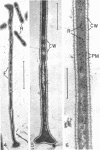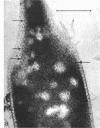Abstract
The physiology of the bacteria living in Boulder Spring (Yellowstone National Park) at 90 to 93 C was studied with radioactive isotope techniques under conditions approximating natural ones. Cover slips were immersed in the spring; after a fairly even, dense coating of bacteria had developed, these cover slips were incubated with radioactive isotopes under various conditions and then counted in a gas flow or liquid scintillation counter. Uptake of labeled compounds was virtually completely inhibited by formaldehyde, hydrochloric acid, and mercuric bichloride, and inhibition was also found with streptomycin and sodium azide. The water of Boulder Spring contains about 3 μg of sulfide per ml. Uptake of labeled compounds occurs only if sulfide or another reduced sulfur compound is present during incubation. The pH optimum for uptake of radioactive compounds by Boulder Spring bacteria is 9.2, a value near that of the natural spring water (8.9). Many experiments with a variety of compounds were performed to determine the temperature optimum for uptake of labeled compounds. The results with all the compounds were generally similar, with broad temperature optima between 80 and 90 C, and with significant uptake in boiling (93 C) but not in superheated water (97 C). The results show that the bacteria of Boulder Spring are able to function at the temperature of their environment, although they function better at temperatures somewhat lower. The fine structure of these bacteria has been studied by allowing bacteria in the spring to colonize glass slides or Mylar strips which were immediately fixed, and the bacteria were then embedded and sectioned. The cell envelope structure of these bacteria is quite different from that of other mesophilic or thermophilic bacteria. There is a very distinct plasma membrane, but no morphologically distinct peptidoglycan layer was seen outside of the plasma membrane. Instead, a rather thick diffuse layer was seen, within which a subunit structure was often distinctly visible, and connections frequently occurred between this outer layer and the plasma membrane. The thick outer layer usually consisted of two parts, the outer part of which was sometimes missing. Within the cells, structures resembling ribosomes were seen, and regions lacking electron density which probably contained deoxyribonucleic acid were also visible.
Full text
PDF











Images in this article
Selected References
These references are in PubMed. This may not be the complete list of references from this article.
- Bott T. L., Brock T. D. Bacterial growth rates above 90 degrees C in Yellowstone hot springs. Science. 1969 Jun 20;164(3886):1411–1412. doi: 10.1126/science.164.3886.1411. [DOI] [PubMed] [Google Scholar]
- Brock T. D., Darland G. K. Limits of microbial existence: temperature and pH. Science. 1970 Sep 25;169(3952):1316–1318. doi: 10.1126/science.169.3952.1316. [DOI] [PubMed] [Google Scholar]
- Brock T. D., Edwards M. R. Fine structure of Thermus aquaticus, an extreme thermophile. J Bacteriol. 1970 Oct;104(1):509–517. doi: 10.1128/jb.104.1.509-517.1970. [DOI] [PMC free article] [PubMed] [Google Scholar]
- Hageage G. J., Jr, Eanes E. D., Gherna R. L. X-ray diffraction studies of the sulfur globules accumulated by Chromatium species. J Bacteriol. 1970 Feb;101(2):464–469. doi: 10.1128/jb.101.2.464-469.1970. [DOI] [PMC free article] [PubMed] [Google Scholar]









